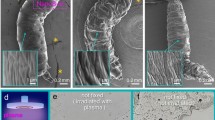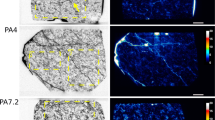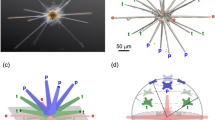Abstract
EXISTING methods1–3 for the study of the radioactivity of thin sections of rock using ‘Nuclear Research’ photographic plates suffer from difficulties in technique. The use of a photographic plate to study the distribution of radioactivity in a thin section of rock entails the removal of the rock section from the emulsion during processing, followed by accurate replacement so that emulsion and section can be examined together. Accurate replacement of the section by mechanical means in its original position relative to the emulsion is obviously difficult, and in addition, since emulsion and thin section must be viewed through the thickness of the glass plate, normal immersion objectives of high resolving power cannot be used. The accurate correlation of alpha-tracks in the emulsion with specific mineral grains or boundaries is also complicated by the presence of an air gap between section and emulsion during exposure, especially in the case of alpha-tracks which may enter the emulsion at small angles of incidence. The error in correlation due to the presence of this air gap may be aggravated if distortion of the emulsion should occur during processing, or if the surface of the emulsion should need to be cleaned before examination.
This is a preview of subscription content, access via your institution
Access options
Subscribe to this journal
Receive 51 print issues and online access
$199.00 per year
only $3.90 per issue
Buy this article
- Purchase on Springer Link
- Instant access to full article PDF
Prices may be subject to local taxes which are calculated during checkout
Similar content being viewed by others

References
Poole, J. H. J., and Bremner, J. W., Nature, 161, 884 (1948).
Poole, J. H. J., and Bremner, J. W., Nature, 163, 130 (1949).
Picciotto, E. E., Bull. Centre de Phys. Nucleaire de l'Univ. Libre de Brux., Note No. 16 (1950).
Yagoda, H., “Radioactive Measurements with Nuclear Emulsions” (New York and London, 1949).
Author information
Authors and Affiliations
Rights and permissions
About this article
Cite this article
FORD, I. Radioactivity of Rocks: an Improvement in the Photographic Technique. Nature 167, 273–274 (1951). https://doi.org/10.1038/167273b0
Issue Date:
DOI: https://doi.org/10.1038/167273b0
This article is cited by
-
Autoradiography with plant tissue
The Botanical Review (1957)
-
Determination of uranium content in radioactive minerals by autoradiography
Proceedings of the Indian Academy of Sciences - Section A (1956)
-
Observations des émulsions nucléaires en lumière réfléchie
Il Nuovo Cimento (1955)
-
Problems of nuclear geophysics
Il Nuovo Cimento (1954)
-
Studio della radioattività di lave vesuviane
Il Nuovo Cimento (1951)
Comments
By submitting a comment you agree to abide by our Terms and Community Guidelines. If you find something abusive or that does not comply with our terms or guidelines please flag it as inappropriate.


